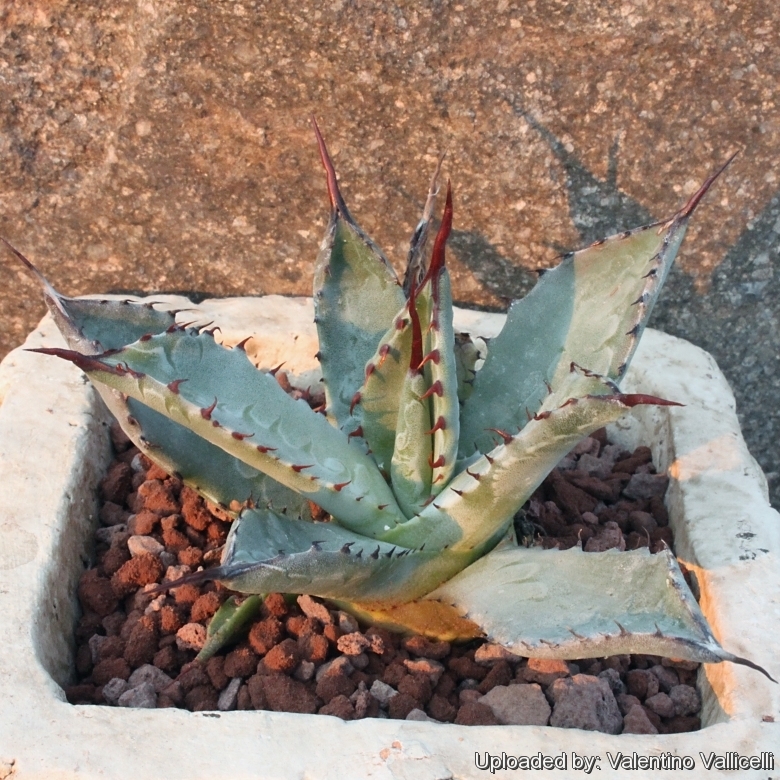Accepted Scientific Name: Agave palmeri
Trans. Acad. Sci. St. Louis 3: 319 1875

Agave palmeri Ruby, Arizona. Photo by: Valentino Vallicelli
Origin and Habitat: Ruby, Arizona (South of Tucson)
Synonyms:
See all synonyms of Agave palmeri
back
Accepted name in llifle Database:Agave palmeri Engelm.Trans. Acad. Sci. St. Louis 3: 319 1875Synonymy: 2
Accepted name in llifle Database:Agave palmeri subs. chrysantha (Peebles) B.UllrichAnder. Sukkulenten 18: 4 (1991 publ. 1992);. cf. Repert. Pl. Succ. (I.O.S.), 43: 5 (1992 publ. 1993)Synonymy: 2
back
Description: It is a compact agave with blue-green leaves. A. palmeri is closely related to Agave schrevei, Agave chrysanthaSN|375]]SN|375]], Agave applanata and Agave murphevi.
Rosettes: Medium-sized to 40-90(-150) cm tall 60-120(-150) cm in diameter. In the wild it doesn’t produce offsets, but occasionally produces them in cultivation.
Leaves: Blue-green to grey-green sometimes marked with transverse ridges, narrow, lance-shaped and flexible up to 60 cm long, 6-10 cm. broad, quite thick, especially at the base and often twisted in all directions. Margin with many reddish brown teeth 3-6 mm long, 1-2 cm apart developed on a nipple, especially present in the second part of the leaf-blade. It has a strong terminal spine 2-6 cm long. Often leaves take purple-red nuances under stress conditions.
Inflorescence: 2-3,5(-5) m tall, often to 12 cm in diameter at base, branched with horizontal branches in the upper one-half of the stalk.
Flowers: Greenish yellow, clustered at the ends of the lateral branches. Fowers in clusters, 4-5,5 cm. long, tube to15 mm. deep; perianth segments about equaling tube, greenish with purple; stamens inserted near middle of tube; filaments 3-5 cm. long, purplish anthers, 12-18 mm. long, greenish yellow; ovary 3-5 mm. long, 6-7 mm. in diameter.
Blooming season: Flower stalks begin to appear in late spring at the end of its life cycle, with full flowering occurring in mid-summer.
Fruit: Capsule cylindrical to narrowly obpyriform, 15-17 mm. in diameter at apex, 5-6 mm. wider at base, 4-6,5 cm. long.
Seeds: 4 mm. wide, 5-6 mm. long, compressed.
Remarks: The so called A. palmeri “Ruby” is the more common form in cultivation, it comes from the area of Ruby, Arizona. It is flushed in purple-red when grown in full sun. The correct determination of many species of agaves is very difficult in young specimens with less than 2-4 years of age, depending on species. Some characteristics like colours, shapes of leaves, shape of the plants, size and distribution of apical and lateral spines are often variable in the early years. Most species have a juvenile stage. Moreover, within the same planting, despite identical dimensions, the plants can acquire the definitive character at very different ages.
Subspecies, varieties, forms and cultivars of plants belonging to the Agave palmeri group
- Agave palmeri Engelm.: has rosettes less than 120 cm Ø. Leaf margin mostly straight teeth 3-5 mm long. Flowers are pale greenish yellow.
 Agave palmeri subs. chrysantha (Peebles) B.Ullrich: has rosettes up to 180 cm or rarely 215 cm Ø. Leaf margin mostly wavy to undulate, teeth 4-10 mm long. Flowers are bright golden yellow, smaller with shallower tube. Umbels more congested with shorter panicles.
Agave palmeri subs. chrysantha (Peebles) B.Ullrich: has rosettes up to 180 cm or rarely 215 cm Ø. Leaf margin mostly wavy to undulate, teeth 4-10 mm long. Flowers are bright golden yellow, smaller with shallower tube. Umbels more congested with shorter panicles. Agave palmeri Ruby, Arizona.
Agave palmeri Ruby, Arizona.
Cultivation and Propagation: Agave palmeri is hardy to about – 12° C, drought tolerant, growing on 250 to 500 mm of annual rainfall. To achieve the most compact rosettes and best colour, plant Agave palmeriSN|22538]]SN|22538]] in full sun. As with other Agave species, this one is tolerant of most soils, but should not be over-watered if drainage is poor.
Propagation: Seeds.










